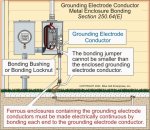- Location
- Placerville, CA, USA
- Occupation
- Retired PV System Designer
Bill just take out the emt and install a piece of pvc. Is it not worth making it right if you are not certain. I agree you shouldn't have to but why not. Explain to the home owner the situation
So you think that putting a large ferrite choke around a GEC will not compromise it's ability to carry a 60Hz or lightning induced surge? That is what the OP has, just not quite as extreme.


